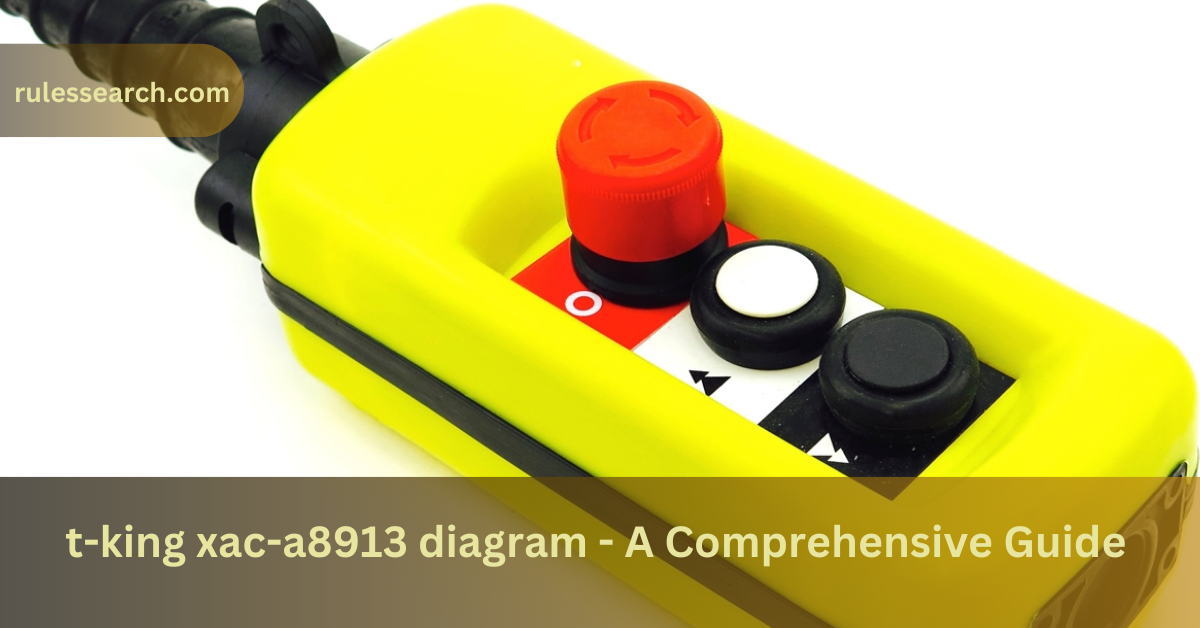Industrial equipment often comes with complex diagrams that can be overwhelming, especially for those unfamiliar with technical details. The T-King XAC-A8913 is a device widely used in various industries and commercial establishments due to its reliability and functionality. However, understanding its diagram is crucial for effective operation and maintenance. This guide will break down the T-King XAC-A8913 diagram, providing detailed explanations of its components and offering insights to help users navigate its complexity with ease.
Introduction to the t-king xac-a8913 diagram
The t-king xac-a8913 diagram is a robust piece of industrial equipment designed to perform in demanding environments. Its versatile applications range from manufacturing plants to construction sites, making it a valuable asset in multiple industries. However, its effectiveness is largely dependent on a clear understanding of its operational diagram, which outlines the various components and their interactions.
The Importance of Diagrams in Industrial Equipment
Diagrams play a pivotal role in the industrial sector. They provide a visual representation of the equipment, helping operators and technicians understand how the various parts work together. For the t-king xac-a8913 diagram, its diagram is not just a schematic but a critical tool for ensuring proper operation, troubleshooting, and maintenance.
Breaking Down the T-King XAC-A8913 Diagram
1. Power Supply and Electrical Connections
- Description: The power supply section of the T-King XAC-A8913 diagram illustrates how the device is powered and how electrical connections are established.
- Key Insights: Proper understanding of this section is essential for safe and efficient operation. Incorrect connections can lead to malfunctions or even safety hazards.
2. Control Panel Overview
- Description: The control panel is the brain of the T-King XAC-A8913, where operators input commands and control various functions.
- Key Insights: Familiarity with the control panel layout and its indicators is crucial for smooth operation. The diagram provides a detailed look at each control, including switches, buttons, and displays.
3. Mechanical Components
- Description: This section of the diagram covers the physical and mechanical elements of the T-King XAC-A8913.
- Key Insights: Understanding the mechanical layout helps in identifying potential wear and tear, ensuring timely maintenance and reducing downtime.
4. Safety Features
- Description: Safety is a priority in any industrial setting, and the T-King XAC-A8913 is equipped with multiple safety features.
- Key Insights: The diagram outlines these safety mechanisms, including emergency stop buttons, overload protection, and warning indicators. Understanding these can prevent accidents and prolong the equipment’s life.
How to Interpret the T-King XAC-A8913 Diagram Effectively
Interpreting industrial diagrams requires a systematic approach. Here’s how you can make the most of the T-King XAC-A8913 diagram:
- Start with the Basics: Begin by familiarizing yourself with the legend or key that explains the symbols used in the diagram.
- Follow the Flow: Trace the connections and flow from the power supply through to the output. This will give you a clear understanding of how the device operates.
- Identify Critical Points: Look for areas marked as critical or sensitive, which require special attention during operation or maintenance.
Common Issues and Troubleshooting Using the T-King XAC-A8913 Diagram
Despite its robust design, the T-King XAC-A8913 may encounter issues during operation. The diagram is an invaluable tool for troubleshooting common problems:
- Power Issues: If the device fails to power on, the diagram can help trace the problem to the power supply or electrical connections.
- Control Panel Malfunctions: Issues with the control panel can often be diagnosed by referring to the diagram to check connections and settings.
- Mechanical Failures: The diagram aids in identifying mechanical components that may need repair or replacement.
Maintenance Tips for the t-king xac-a8913 diagram
Regular maintenance is key to ensuring the longevity and efficiency of the T-King XAC-A8913. Here are some maintenance tips based on the diagram:
- Routine Inspections: Regularly inspect electrical connections and mechanical components as indicated in the diagram.
- Lubrication: Ensure that moving parts are properly lubricated to prevent wear and tear.
- Safety Checks: Periodically test the safety features to ensure they are functioning correctly.
Customizing the t-king xac-a8913 diagram for Specific Applications
The versatility of the t-king xac-a8913 diagram means it can be customized for specific industrial applications. Understanding the diagram allows for modifications that can enhance performance for particular tasks. For example:
- Enhanced Power Supply: Upgrading the power supply for higher voltage applications.
- Control Panel Customization: Adding or modifying controls for specialized operations.
Conclusion
The T-King XAC-A8913 is a powerful tool in the industrial sector, and understanding its diagram is essential for maximizing its potential. By breaking down the diagram into manageable sections and providing detailed insights, this guide aims to help users operate and maintain the T-King XAC-A8913 effectively and safely.
FAQs About the T-King XAC-A8913 Diagram
1. What is the purpose of the T-King XAC-A8913 diagram?
The diagram serves as a visual guide to understanding the components and connections of the t-king xac-a8913 diagram, helping operators and technicians ensure proper operation and maintenance.
2. How can I ensure the correct power supply connection?
Refer to the power supply section of the diagram, which outlines the correct wiring and connection points to prevent malfunctions.
3. What should I do if the control panel is not responding?
Check the diagram to trace the connections from the control panel to the power supply and other components. Ensure all connections are secure and properly configured.
4. How often should I perform maintenance on the T-King XAC-A8913?
Regular maintenance should be performed as indicated in the diagram, with inspections every few months and lubrication of mechanical parts as needed.
5. Can I customize the T-King XAC-A8913 for specific tasks?
Yes, the diagram can guide you in making modifications to the power supply, control panel, or mechanical components to suit specific industrial applications.
6. What safety features are included in the T-King XAC-A8913?
The diagram highlights various safety features, including emergency stop buttons, overload protection, and warning indicators, all of which are crucial for safe operation.
7. How do I interpret the symbols in the diagram?
The legend or key provided with the diagram explains the symbols used, making it easier to understand the connections and components.
8. What are the most common issues with the T-King XAC-A8913, and how can the diagram help?
Common issues include power supply failures and control panel malfunctions. The diagram helps in troubleshooting by providing a clear view of the connections and components involved.
9. Is the T-King XAC-A8913 suitable for all industrial applications?
The T-King XAC-A8913 is versatile but may require customization for specific applications, which can be guided by the diagram.
10. How can I safely operate the T-King XAC-A8913?
Safe operation involves following the diagram for correct connections, understanding the control panel, and regularly testing safety features as outlined in the diagram.



